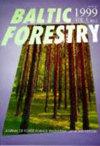Salinity and temperature influencing seed germination of Mediterranean Aleppo pine (Pinus halepensis Mill.): an ecological adaptation to saline environments
IF 0.6
4区 农林科学
Q3 FORESTRY
引用次数: 1
Abstract
In Mediterranean basin, Pinus halepensis Mill. is the dominant conifer used in afforestation and landscape projects. The ecological, aesthetic and commercial benefits make this conifer a precious tree for both woody production and land rehabilitation. Nevertheless, detailed studies on the adaptation of this tree to abiotic environmental constraints in the Mediterranean areas remain limited up until now. Therefore, laboratory experiments were conducted to assess the effects of the interactive impact of temperatures and salinity on the germinability potential of P. halepensis seeds. The cones of P. halepensis used in this experiment were harvested from the Gotaïa forest at Djelfa province, Algeria. The seeds were removed from their cones and surface-sterilized by soaking for five min in 10% NaClO. Seeds were germinated at three temperature regimes (10–20 °C, 15–25 °C and 20–30 °C) and four levels of salinity (0, 50, 100, and 150 mM NaCl) at photoperiodic lighting (16 h of light : 8 h of dark). For each treatment 04 replicates of 25 seeds were placed in Petri dish with 5 ml of test solutions. A completely randomized design (CRD) was used for the experiment. Results revealed that the uppermost germinability was recorded in distilled H2O and the progressive enhancement of NaCl significantly (P < 0.001) suppressed germination. At 15–25 °C (dark : light thermoperiod), P. halepensis seeds showed approximately 90% of germination at 0 mM NaCl. However less germination percentage (GP) was obtained at 10–20 °C and 20–30 °C. Values of Timson’s index were also suppressed significantly (P < 0.001) with an increase under salt stress at all thermoperiods but at least at 15–25 °C. These funding suggest that seeding of P. halepensis may be an effective path for rehabilitation of degraded lands where salinity and drought are major features of the arid ecosystems. Yet, this conclusion still needs verification by field experiments. Key words: Pinus halepensis; arid zones; sowing dates; afforestation; salt tolerance盐度和温度对地中海阿勒颇松种子发芽的影响:对盐碱环境的生态适应
在地中海盆地,有白松。是造林和景观工程中使用的主要针叶树。生态、美学和商业效益使这种针叶树成为木材生产和土地恢复的珍贵树木。然而,迄今为止,关于这种树适应地中海地区非生物环境限制的详细研究仍然有限。因此,进行了实验室实验,以评估温度和盐度的相互作用对哈勒彭斯P.halepensis种子发芽潜力的影响。本实验中使用的P.halepensis的球果是从阿尔及利亚杰尔法省的Gotaïa森林中收获的。将种子从球果中取出,并通过在10%NaClO中浸泡5分钟进行表面消毒。种子在三种温度条件(10-20°C、15-25°C和20-30°C)和四种盐度水平(0、50、100和150 mM NaCl)下,在光周期光照下发芽(光照16小时:黑暗8小时)。对于每个处理,将25个种子的04个重复物与5毫升测试溶液一起放置在培养皿中。实验采用完全随机设计(CRD)。结果表明,在蒸馏水中的发芽率最高,NaCl的逐渐增强显著抑制了发芽(P<0.001)。在15–25°C(暗:光热周期)下,P.halepensis种子在0 mM NaCl下表现出约90%的发芽率。然而,在10-20°C和20-30°C下获得的发芽率(GP)较小。Timson指数的值也被显著抑制(P<0.001),在所有温度段(但至少在15-25°C)的盐胁迫下增加。这些资金表明,在盐度和干旱是干旱生态系统主要特征的退化土地上,播种哈勒彭斯可能是恢复退化土地的有效途径。然而,这一结论仍需通过现场实验加以验证。关键词:白松;干旱区;播种日期;植树造林;耐盐性
本文章由计算机程序翻译,如有差异,请以英文原文为准。
求助全文
约1分钟内获得全文
求助全文
来源期刊

Baltic Forestry
农林科学-林学
CiteScore
1.60
自引率
0.00%
发文量
23
审稿时长
>12 weeks
期刊介绍:
The journal welcomes the original articles as well as short reports, review papers on forestry and forest science throughout the Baltic Sea region and elsewhere in the area of boreal and temperate forests. The Baltic Sea region is rather unique through its intrinsic environment and distinguished geographical and social conditions. A temperate climate, transitional and continental, has influenced formation of the mixed coniferous and deciduous stands of high productivity and biological diversity. The forest science has been affected by the ideas from both the East and West.
In 1995, Forest Research Institutes and Universities from Estonia, Latvia and Lithuania
joined their efforts to publish BALTIC FORESTRY.
 求助内容:
求助内容: 应助结果提醒方式:
应助结果提醒方式:


